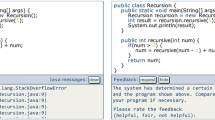Abstract
This paper describes a three-tier architecture for general intelligent tutoring systems — at the top level are the general objectives and their reasoning that infer, control and explain the instruction strategies; at the middle level is the planning mechanism that resolves the needs for the general behaviour of teaching; and at the bottom level is the execution of methods that reflect the specific behaviour of teaching.
We also present a knowledge representation for general instructional objectives and their reasoning mechanism. Two fundamental design issues are addressed: (a) the epistemological adequacy of the objectives — easy to interpret for human and machine alike; and (b) the generality of the objectives — independent of the subject matter. We argue that the proposed architecture and knowledge representation can support an “instructional objectives first” approach which help to develop ITSs efficiently and communicate the studies to other researchers.
Preview
Unable to display preview. Download preview PDF.
Similar content being viewed by others
Bibliography
Anderson, J.R. 1988, The expert module', in Psotka, J., Massey, L.D. & Mutter, S.A., eds., Intelligent Tutoring Systems: Lessons Learned, Lawrence Erlbaum Associates Publishers, Hillsdale, New Jersey, pp. 21–53.
Breuker, J. 1988, ‘Coaching in help systems', in Self, J., ed., Artificial Intelligence and Human Learning, Chapman and Hall, London, pp. 310–337.
Brown, R.R. & Burton, J.S. 1982, ‘An investigation of computer coaching for informal learning activities', in Sleeman, D. & Brown, J.S., eds., Intelligent Tutoring Systems, Academic Press, London, pp. 79–98.
Clancey 1982, Tutoring rules for guiding a case method dialogue', in Sleeman, D. & Brown, J.S., eds., Intelligent Tutoring Systems, Academic Press, London, pp. 201–225.
Clancey, W.J. 1986a, ‘Qualitative student models', Annual Review of Computer Science, vol. 1, pp. 381–450.
Clancey, W.J. 1986b, ‘From GUIDON to NEOMYCIN and HERACLES in twenty short lessons: ONR final report 1979–1985', AI Magazine, vol. 7, no. 3, pp. 40–60.
Clancey, W.J. 1987, Knowledge-Based Tutoring: The GUIDON Program, MIT Press, Cambridge, Massachusetts.
Clancey, W.J., Shortliffe, E.H. & Buchanan, B.G. 1979, ‘Intelligent computer-aided instruction for medical diagnosis', Proceedings of the Third Annual Symposium on Computer Applications in Medical Computing, Silver Springs, Md., October, pp. 175–183.
Corbet, A.T., Anderson, J.R. & Patterson, E.G. 1990, ‘Student modeling and tutoring flexibility in the LISP intelligent tutoring system', in Frasson, C. & Gauthier, G., eds., Intelligent Tutoring Systems: At the Crossroad of Artificial Intelligence and Education, Ablex Publishing Corporation, Norwood, New Jersey, pp. 83–106.
Macmillan, S.A., Emme, D. & Berkowitz, M. 1988, ‘Instructional planners: Lesson learned', in Psotka, J., Massey, L.D. & Mutter, S.A., eds., Intelligent Tutoring Systems: Lessons Learned, Lawrence Erlbaum Associates Publishers, Hillsdale, New Jersey, pp. 229–256.
Murray, T. & Woolf, B.P. 1991, ‘A knowledge acquisition tools for intelligent computer tutors', SIGART Bulletin, vol. 2, no. 2, pp. 9–21.
Murray, W.R. 1990, ‘A blackboard-based dynamic instructional planner', Proceedings Eighth National Conference on Artificial Intelligence, pp. 434–441.
Reigeluth, C.M. & Stein, F.S. 1983, The elaboration theory of instruction', in Reigeluth, C.M., ed., Instructional-design Theories and Models: An Overview of Their Current Status, Lawrence Erlbaum Associates, Hillsdale, New Jersey, pp. 336–381.
Reigeluth, C.M. (ed.) 1983, Instructional-design Theories and Models: An Overview of Their Current Status, Lawrence Erlbaum Associates, Hillsdale, New Jersey.
Reigeluth, C.M. (ed.) 1987, Instructional Theories in Action: Lesson Illustrating Selected Theories and Models, Lawrence Erlbaum Associates, Hillsdale, New Jersey.
Russell, D.M. 1988 IDE: The interpreter', in Psotka, J., Massey, L.D. & Mutter, S.A., eds., Intelligent Tutoring Systems: Lessons Learned, Lawrence Erlbaum Associates Publishers, Hillsdale, New Jersey, pp. 323–349.
Russell, D.M., Moran, T.P. & Jordan, D.S. 1988, The instructional-design environment', in Psotka, J., Massey, L.D. & Mutter, S.A., eds., Intelligent Tutoring Systems: Lessons Learned, Lawrence Erlbaum Associates Publishers, Hillsdale, New Jersey, pp. 203–228.
Self, J.A. 1990, ‘Bypassing the intractable problem of student modelling', in Frasson, C. and Gauthier, G., eds., Intelligent Tutoring Systems: At the Crossroad of Artificial Intelligence and Education., Ablex Publishing Corporation, Norwood, New Jersey, pp.. 107–123.
Sleeman, D. & Brown, J.S. 1982, Intelligent Tutoring Systems, Academic Press, London.
Woolf, B.P. & McDonald, D.D. 1984, ‘Building a computer tutor: Design issues', Computer, September, pp. 61–73.
Yum, K.-K. & Richards, T.J. 1992, 'simulating teaching by reasoning about instructional objectives', to be presented in the Third Annual Conference on AI, Simulation and Planning in High Autonomy Systems (AIS'92), 8–10 July, Perth, Western Australia.
Yum, K.-K. & Richards, T.J. forthcoming, 'structuring topics for presentation using feature networks'.
Author information
Authors and Affiliations
Editor information
Rights and permissions
Copyright information
© 1992 Springer-Verlag Berlin Heidelberg
About this paper
Cite this paper
Yum, K.K., Richards, T.J. (1992). Instruction as reasoning about multiple objectives. In: Frasson, C., Gauthier, G., McCalla, G.I. (eds) Intelligent Tutoring Systems. ITS 1992. Lecture Notes in Computer Science, vol 608. Springer, Berlin, Heidelberg. https://doi.org/10.1007/3-540-55606-0_26
Download citation
DOI: https://doi.org/10.1007/3-540-55606-0_26
Published:
Publisher Name: Springer, Berlin, Heidelberg
Print ISBN: 978-3-540-55606-0
Online ISBN: 978-3-540-47254-4
eBook Packages: Springer Book Archive




